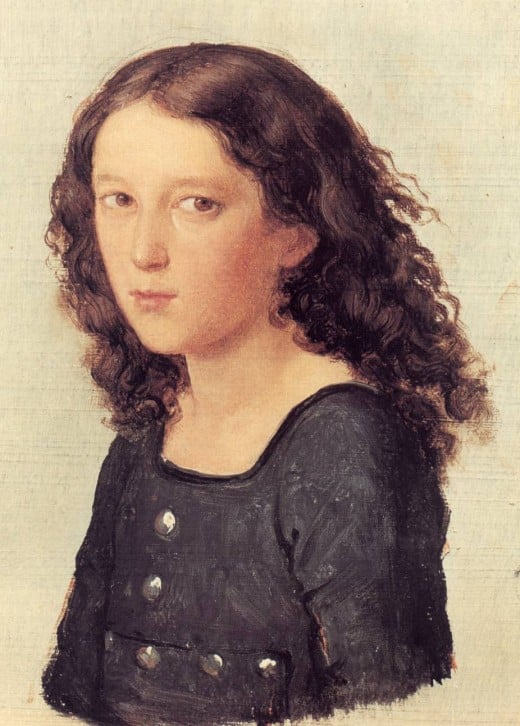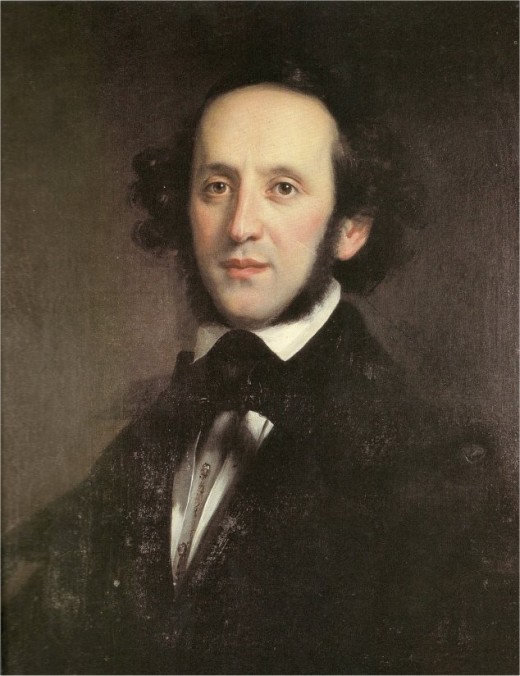The Mendelssohnian Touch: An Overview of Felix Mendelssohn's Keyboard Works
In his day, Felix Mendelssohn was a highly respected composer, and was especially known as a brilliant performer.[1] Sadly, since then his music has been, though not completely ignored, at least sorely neglected. His keyboard works in particular have not received the recognition they deserve. His larger keyboard works especially go unplayed, even though pieces like his Variations Sérieuses display his understanding of form, heightened sense of emotion, and taste for virtuosic stylistic elements.

![Felix Mendelssohn Bartholdy at the age of 30 in London; By Creator:James Warren Childe (watercolor painting) [Public domain], via Wikimedia Commons Felix Mendelssohn Bartholdy at the age of 30 in London; By Creator:James Warren Childe (watercolor painting) [Public domain], via Wikimedia Commons](https://usercontent2.hubstatic.com/5071501_f520.jpg)
![Felix Mendelssohn Bartholdy; By Eduard Bendemann [Public domain], via Wikimedia Commons Felix Mendelssohn Bartholdy; By Eduard Bendemann [Public domain], via Wikimedia Commons](https://usercontent2.hubstatic.com/5071503_f520.jpg)
![Felix Mendelssohn Bartholdy; By Friedrich Jentzen (1815-1901); painting by Theodor Hildebrandt (1804-1874) [Public domain], via Wikimedia Commons Felix Mendelssohn Bartholdy; By Friedrich Jentzen (1815-1901); painting by Theodor Hildebrandt (1804-1874) [Public domain], via Wikimedia Commons](https://usercontent1.hubstatic.com/5071504_f520.jpg)

Biography
Jakob Ludwig Felix Mendelssohn was born on February 3, 1809, in Hamburg, Germany. Unlike many of his contemporary composers, Felix was born into a family who had both money and social status. His parents, Leah and Abraham Mendelssohn, were able to both encourage and provide for the development of musical abilities in Felix and his older sister Fanny, with whom he was very close. Early in Felix’s life, his family converted from Judaism to Christianity, hoping that this would open even more social doors. Felix was baptized in the Lutheran church, and remained in that denomination for the rest of his life. The family name was changed to Bartholdy, though Felix elected to keep both names and today is more commonly known by the Jewish “Mendelssohn.”[2]
The family moved to Berlin in 1812, and it is there that Mendelssohn began his musical education. His mother gave both him and Fanny their first piano lessons. Felix eventually moved on to take lessons from teachers like Ludwig Berger, Marie Bigot, and Carl Friedrich Zeller. In 1819, Felix joined the Berlin Singakademie and later that year the academy performed a composition that he had written on Psalm 19—just one sign of his prodigious childhood. He began performing and composing at an early age.[3] At fifteen he wrote his Octet in E-flat for Strings (opus 20) and just a year later he composed what is considered to be his first mature work, his Overture to Ein Sommernachtstraum (A Midsummer Night’s Dream ).[4]
His education continued at the University of Berlin where he studied history and geography for four semesters. In March of 1829, during his last semester at university, Mendelssohn put together and directed a performance of Johann Sebastian Bach’s St. Matthew Passion .[5] This was the first public performance of the piece in one hundred years and it led to a reawakening of interest in the music of a man who, alongside Beethoven, would be one of Mendelssohn’s biggest influences.
Later that same year, Mendelssohn traveled to England and conducted his own Symphony in c minor (opus 11—his first symphony). He was subsequently made an honorary member of the London Philharmonic Symphony.[6] Mendelssohn travelled quite a bit in his early twenties, and from these escapades emerged several of his best known works. His tour through Scotland inspired the Scotch Symphony and the Hebrides Overture . 1830 brought him to and three years later he produced his Italian Symphony .[7]
It was not until 1833 that he settled down in Germany, at least for a little while. He conducted in Düsseldorf for a festival, and was soon given the position of Kapellmeister in that city, where his duties put him in charge of the local church music, municipal opera, and two singing societies.[8] Two years later, he was appointed as the conductor of the Leipzig Gewandhaus Orchestra. With his skills as a conductor, he brought the orchestra’s skill and renown to new heights.[9]
While still in Leipzig, Mendelssohn fell in love with his landlady’s daughter—Cécile Jeanneneud. The two were married in 1837 and appeared to have an atypically harmonious home life.[10] In 1841, the Mendelssohn’s moved to Berlin where Felix was given the title Royal General Music Director.[11] He soon became frustrated with the politics involved with the position, however, and spent the majority of his time in England and Leipzig, where he helped to establish the Leipzig Conservatory in 1843.[12]
Unfortunately, Mendelssohn’s numerous duties and hectic schedule caused him to become more and more frustrated with his work. This eventually led to a nervous breakdown. Already in an unhealthy state when his beloved sister Fanny died in May of 1847, Mendelssohn spiraled into a dangerous depression.[13] He finally died in Leipzig on November 4, 1847.[14]
Keyboard Music
Though Mendelssohn is probably most renowned for his orchestral compositions, his keyboard works are not without importance. Of his works for piano, his Lieder ohne Worte (Songs without Words) are the most often taught and played. Mendelssohn wrote forty-nine of these character pieces, which are divided into eight volumes of six, with one discovered posthumously.[15] The pieces reflect their name, and are generally composed of a lyrical melody over an accompanimental pattern. Programmatic references are limited; only four were originally given descriptive titles (Volkslied and three called Venetianisches Gondellied) and two acquired names later (Jägerlied and Spinnerlied). Mendelssohn’s other character pieces include his Characterstücke (a set of seven), and several capriccios and caprices.[16]
Other small forms in which Mendelssohn composed include preludes and fugues. He wrote three preludes in 1836, which are grouped with three etudes in opus 104, and continued with six sets of preludes and fugues the following year (opus 35). Another prelude and fugue were composed later for an anthology published in the 1840s. These works show the great influence of Johann Sebastian Bach on Mendelssohn, not only because the prelude and fugue are essentially “Bach’s form,” but also because of the Bachian style that Mendelssohn employs. The use of figuration in the opus 104 preludes is especially reminiscent of Bach, as are certain elements in the opus 35 fugues.[17]
Mendelssohn’s larger keyboard works come in three forms: sonatas, fantasias, and themes and variations. His three sonatas are among his earliest compositions (the first composed when he was eleven, the last when he was eighteen), and though they show promise, they are usually not listed with his best works. The first sonata (in g minor) is a smaller work made up of three movements, two of which are in sonata form. The other two (in E and B-flat) each have four movements and are in cyclic form (meaning the beginning ideas reoccur later in the piece), but only the first movement of the B-flat sonata is written in sonata form.
Mendelssohn’s Fantasia in F-sharp, a larger work played in three movements without pause, is often associated with the sonatas because its last movement employs sonata-allegro form. The Fantasia is often called the Sonata écossaise (Scotch Sonata ). His Fantasia on an Irish Song (The Last Rose of Summer ) is the only other fantasia of significant dimensions that Mendelssohn composed, and it is much smaller than the Scotch Sonata . Finally come the themes and variations, of which there are three: the Variations sérieuses in d, Variations in E-flat, and Variations in B-flat.[18]
The Serious Variations
Though still relatively unknown, it is the Variations sérieuses that have earned a place in performance repertoire.[19] These d minor variations were originally written for an anthology of works by leading composers of the day. The proceeds from the volume were used to erect a monument to Beethoven in Bonn. When, in 1841, Pietro Mechetti first asked Mendelssohn for a contribution, the composer declined because “in his mind the pledge was linked with lofty artistic demands,” but with some persuasion he agreed to attempt something and began work.[20] On July 15, 1841, Mendelssohn wrote:
“Do you know what I have been doing so passionately for the last few weeks? – variations for piano. Eighteen of them at one go, on a theme in D minor; and they gave me such divine pleasure that I immediately wrote a new set on a theme in E flat major [op. 82], and am now working on a third on a theme in B flat [op. 83]. I almost feel as if I have to make amends for not having written variations before. The first ones in D minor, are very dear to me so far, and will appear in a Viennese album for the benefit of the Beethoven monument in Bonn. Moscheles has also included a piece of his; you will probably be seeing and hearing them in short order.[21]”
The work underwent quite a bit of revision between the original draft and the published version. After several additions, deletions, and re-ordering of variations, the work finally appeared on January 18, 1842. The variations were printed alongside pieces like Frédéric Chopin’s Prélude in c-sharp minor, Carl Czerny’s Nocturne in E-flat major, Adolf Henselt’s Wiegenlied in G-flat major, and other works by Franz Liszt, Theodor Döhler, Frédéric Kalkbrenner, Ignaz Moscheles, and Wilhelm Taubert.[22]
The piece itself contains a sixteen measure theme, seventeen variations, and a coda (marked presto ). Somewhat unusual for a set of variations, the sixteen measure theme is written in free form “without the usual divisions or any internal repetitive structure, with many suspensions, and with much chromaticism.”[23] Christa Jost explains the ordering of the variations in this way:
“Mendelssohn, then, does not manipulate the bass of his theme but rather the cantilena. Having broken down its structure in Variations 1 to 4, he then explores and juxtaposes its different characters in Variations 5 to 13. The final section elaborates the double meaning of the “variation motif.” Not even in the brilliance of the coda does he depart from his rigorous musical conception.[24]”
Though in many ways a true Romantic, Mendelssohn is often associated with Classical composers, due in part to his balanced formal sense. While his sonatas may be representative of the decline in that form during the nineteenth century, his character pieces are written in very strict form.[25] Even his interest in themes and variations shows a classical bent. It is notable that the Variations sérieuses were the only contribution to Mechetti’s anthology written in a traditional classical form. Many scholars attribute Mendelssohn’s choice to a desire to pay homage to Beethoven, who excelled in the genre. Whether or not this was the case, Mendelssohn keeps to his chosen form very closely, “eschewing such Beethovinian techniques as the introduction of non-tonic keys or fragments and transitional passages.”[26]
Because of his association with the rather conservative Leipzig Conservatory and Victorian era, Mendelssohn’s ability to access a vast emotional range is often underestimated and stereotyped, which is surprising considering his variations in d minor. Variations, by nature, are expected to be diverse, and Mendelssohn does not disappoint. Through a variety of technical demands and a broad range of dynamics, the composer is able to produce an equally broad range of emotional intensity. Kirby explains in more detail:
“The seventeen variations, as expected, display a variety of different characters: staccato chords alternating between the hands (iii), a long crescendo with sudden changes of dynamics and register (vi), a chromatic fughetta (x), cantabile, the melody in even notes over smooth broken-chord figuration (xi), an Adagio in the parallel major (xiv), followed by an unusual variation that goes from pianissimo to forte and then diminuendo with tied chords in the right hand (xv), and at the end is a brilliant coda.[27]”
Besides his emotional range and use of form, there are several stylistic characteristics common to Mendelssohn that are evident in the Variations sérieuses .[28] His use of rapid figuration can be seen in several variations, from the swirling figures in Variation 2 to the swift triplets in Variations 8 and 9. Similarly, his use of rapid chord repetition is most evident in the Agitato of Variation 5, Variation 12, and the beginning of the final coda (which strongly recalls the Agitato section). His delicate treatment of staccato can be seen as early as Variation 4, but makes its ultimate debut in Variation 13, marked sempre assai leggiero . As mentioned previously, the songlike lyricism so common in the Lieder ohne Worte is heard in the Cantabile of Variation 11. True to his Bachian influence, Mendelssohn scatters brief moments of counterpoint throughout the piece, the culmination of which is found in the fugal Variation 10. His predisposition toward chromaticism is evident right away in the suspensions and inner lines of the theme, and continues throughout the following variations. Finally, his use of virtuosic techniques like fast octaves and arpeggiated chords, while present in Variations 6 and 7, is best displayed in the bravura Variation 17 and the presto that follows it.
With the evidence of form, emotion, and style found in his Variations sérieuses , it is hard to comprehend why there is so little interest in the piece as a performance work, or in the rest of Mendelssohn’s keyboard repertoire. While it is true that his classical sensibilities prevented him from making a great impact on the course of Romantic piano music, Jost aptly notes that “the Variations sérieuses develop a life of their own by placing different eras of history side by side in mutual reflection. In this way Mendelssohn marked out a place of his own vis-à-vis the classical tradition.”[29]
Sources
Gordon, Stewart. A History of Keyboard Literature: Music for the Piano and Its Forerunners. Schirmer: New York, 1996.
Jost, Christa. “In mutual reflection: Historical, biographical, and structural aspects of Mendelssohn’s Variations sérieuses.” In Mendelssohn studies, edited by Larry R. Todd, 33-63. Cambridge UP: Cambridge, 1992.
Kirby, F. E. A Short History of Keyboard Music. Free Press: New York, 1966.
Libbey, Ted. “Mendelssohn-Bartholdy, [Jakob Ludwig] Felix.” In The NPR Listener’s Encyclopedia of Classical Music, 486-487. Workman Publishing: New York, 2006.
Ogdon, John. “The Romantic Tradition.” In Keyboard Music, edited by Denis Matthews, 209-258. Praeger: New York, 1972.
Stanley, Glenn. “The music for keyboard.” In The Cambridge Companion to Mendelssohn, edited by Peter Mercer-Taylor, 149-166. Cambridge UP: Cambridge, 2004.
Steen, Michael. The Lives and Times of the Great Composers. Oxford UP: Oxford, 2010.Footnotes
[1] Ted Libbey. “Mendelssohn-Bartholdy, [Jakob Ludwig] Felix.” In The NPR Listener’s Encyclopedia of Classical Music. Workman Publishing: New York, 2006, 486.; [2] Ibid.; [3] Stewart Gordon. A History of Keyboard Literature: Music for the Piano and Its Forerunners. Schirmer: New York, 1996, 237.; [4] Libbey, 486.; [5] Ibid.; [6] Gordon, 237-238.; [7] Libbey, 486.; [8] Gordon, 238.; [9] Libbey, 486.; [10] Michael Steen. The Lives and Times of the Great Composers. Oxford UP: Oxford, 2010, 356.; [11] Gordon, 238.; [12] Libbey, 486.; [13] Gordon, 238.; [14] Libbey, 486.; [15] Gordon, 239.; [16] F. E. Kirby. A Short History of Keyboard Music. Free Press: New York, 1966, 252-255.; [17] Ibid., 257.; [18] Kirby, 250-251.; [19] Ibid., 251.; [20] Christa Jost. “In mutual reflection: Historical, biographical, and structural aspects of Mendelssohn’s Variations sérieuses.” In Mendelssohn studies, edited by Larry R. Todd. Cambridge UP: Cambridge, 1992, 33.; [21] Ibid., 34.; [22] Jost, 37.; [23] Kirby, 251.; [24] Ibid.; [25] John Ogdon. “The Romantic Tradition.” In Keyboard Music, edited by Denis Matthews. Praeger: New York, 1972, 238.; [26] Glenn Stanley. “The music for keyboard.” In The Cambridge Companion to Mendelssohn, edited by Peter Mercer-Taylor. Cambridge UP: Cambridge, 2004, 162-163.; [27] Kirby, 251.; [28] Gordon, 240.; [29] Jost, 63.




